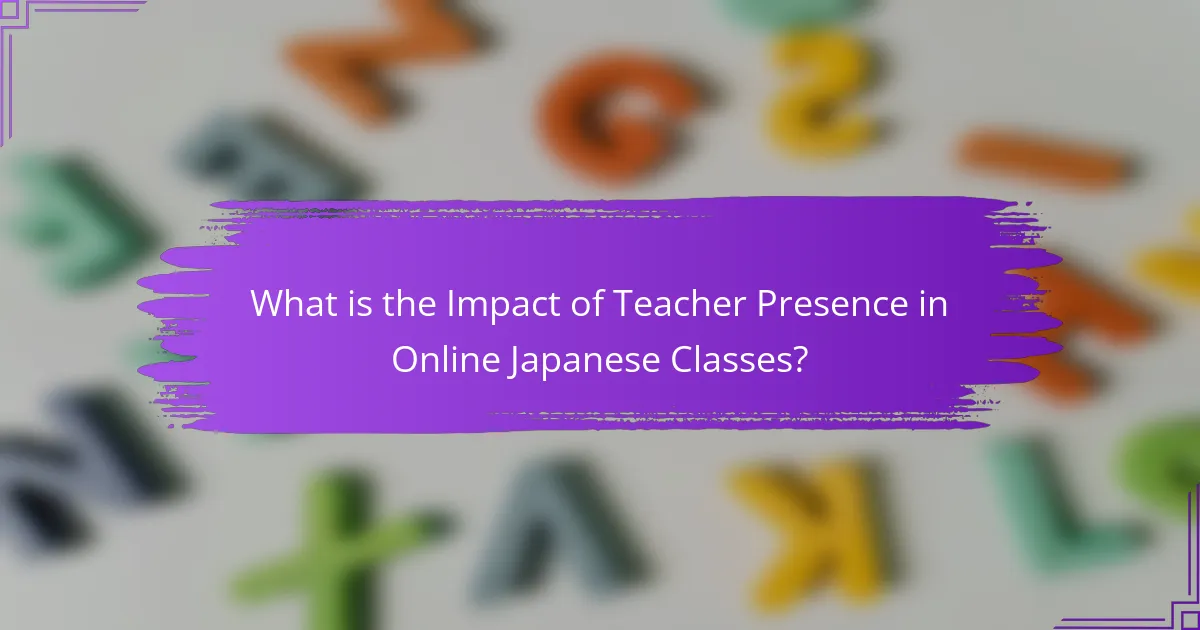
What is the Impact of Teacher Presence in Online Japanese Classes?
Teacher presence significantly enhances student engagement in online Japanese classes. It fosters a sense of community among learners. Active teacher involvement leads to higher participation rates. Research shows that students feel more motivated with visible teacher support. A study by Kuo et al. (2014) indicates that teacher presence is linked to increased satisfaction. This satisfaction correlates with improved learning outcomes. Additionally, personalized feedback from teachers can help clarify complex concepts. Overall, teacher presence is crucial for effective online language instruction.
How does teacher presence influence student engagement in online learning?
Teacher presence significantly enhances student engagement in online learning. It fosters a sense of community and belonging among students. Research indicates that active teacher involvement is linked to higher participation rates. A study by the University of Southern California found that students are more likely to engage when teachers provide timely feedback. Additionally, the use of interactive tools by teachers can increase student motivation. This engagement is critical for academic success in an online environment. Overall, teacher presence plays a vital role in maintaining student interest and involvement in their learning process.
What specific attributes of teacher presence enhance engagement?
Attributes of teacher presence that enhance engagement include immediacy, responsiveness, and authenticity. Immediacy refers to behaviors that foster closeness and connection between the teacher and students. Research shows that immediacy can increase student motivation and participation. Responsiveness involves timely feedback and interaction with students, which creates a supportive learning environment. Studies indicate that prompt responses to student inquiries lead to higher satisfaction and engagement levels. Authenticity encompasses being genuine and relatable, which helps build trust and rapport. Evidence suggests that authentic teacher presence positively influences student engagement and learning outcomes.
How does the level of teacher interaction affect student participation?
Higher levels of teacher interaction significantly enhance student participation. When teachers actively engage with students, it fosters a sense of community. This interaction encourages students to contribute more during discussions. Research indicates that students feel more motivated in interactive environments. A study by Garrison and Anderson (2003) highlights that meaningful interaction leads to deeper learning. Additionally, increased feedback from teachers can boost students’ confidence. This confidence translates to higher participation rates. Overall, effective teacher-student interaction is crucial for active engagement in online classes.
Why is teacher presence critical for student satisfaction in online classes?
Teacher presence is critical for student satisfaction in online classes because it fosters a sense of connection and support. When teachers actively engage with students, it enhances their motivation and participation. Research indicates that students who perceive a strong teacher presence report higher levels of satisfaction and engagement. A study by Garrison and Anderson (2003) found that social presence, which includes teacher interaction, significantly impacts student satisfaction in online learning environments. Furthermore, consistent communication from teachers can reduce feelings of isolation among students. This connection is essential for creating a positive learning atmosphere. Therefore, effective teacher presence directly correlates with improved student satisfaction in online classes.
What role does teacher feedback play in student satisfaction?
Teacher feedback plays a crucial role in student satisfaction. Effective feedback helps students understand their progress and areas for improvement. It fosters a sense of connection between students and teachers. Research shows that timely and constructive feedback increases student motivation. For instance, a study by Hattie and Timperley (2007) highlights that feedback significantly influences learning outcomes. Students who receive regular feedback report higher satisfaction levels. This feedback process also enhances student engagement in online learning environments. Overall, quality teacher feedback is essential for fostering positive student experiences.
How do students perceive the importance of teacher presence in their learning experience?
Students perceive teacher presence as crucial to their learning experience. They believe it enhances engagement and motivation. A study by the University of Southern California found that students reported higher satisfaction when teachers were actively involved. Active teacher presence fosters a sense of community. It also provides immediate feedback, which is essential for learning. Moreover, students feel more supported and connected in their studies. This connection can lead to improved academic performance. Overall, teacher presence significantly influences students’ educational experiences.

What Engagement Strategies Can Teachers Use in Online Japanese Classes?
Teachers can use interactive activities, multimedia resources, and personalized feedback to engage students in online Japanese classes. Interactive activities include quizzes, polls, and discussion forums. These strategies encourage participation and foster a sense of community. Multimedia resources such as videos, songs, and games enhance learning experiences. They cater to different learning styles and maintain student interest. Personalized feedback helps students feel valued and understood. It encourages them to improve and stay motivated. Research shows that teacher presence significantly impacts student satisfaction and engagement in online learning environments.
How can teachers effectively communicate with students in an online setting?
Teachers can effectively communicate with students in an online setting by utilizing clear and concise messaging. They should establish regular communication channels, such as emails, discussion boards, and video conferencing. This ensures that students feel connected and informed. Active engagement is crucial; teachers can ask open-ended questions to encourage participation. Utilizing multimedia resources can enhance understanding and retention of information. Providing timely feedback on assignments fosters a supportive learning environment. According to a study by K. A. Moore and J. E. Kearney, effective communication strategies significantly improve student satisfaction and engagement in online courses.
What tools and platforms facilitate better communication?
Video conferencing tools such as Zoom and Microsoft Teams facilitate better communication in online classes. These platforms allow real-time interaction between teachers and students. Features like screen sharing enhance understanding of the material. Messaging apps like Slack and Discord provide instant communication outside of class hours. They enable students to ask questions and collaborate on projects. Learning management systems like Moodle and Canvas centralize course materials and communication. These systems streamline the flow of information and feedback. According to a study by the Online Learning Consortium, effective communication tools significantly improve student engagement and satisfaction.
How can teachers adapt their teaching styles to enhance engagement?
Teachers can adapt their teaching styles to enhance engagement by incorporating interactive techniques. These techniques include using multimedia resources to create a dynamic learning environment. Research shows that students retain 65% of information when they engage with visual content. Additionally, teachers can implement collaborative learning activities. Group projects encourage peer interaction and foster a sense of community.
Another effective strategy is to provide timely feedback. According to studies, timely feedback can improve student performance by 30%. Teachers can also personalize learning experiences. Tailoring lessons to students’ interests increases motivation and participation. Furthermore, utilizing technology tools can facilitate real-time interaction. Tools like polls and quizzes keep students actively involved during lessons.
Incorporating diverse teaching methods also caters to different learning styles. This approach ensures that all students can connect with the material. Overall, these strategies collectively enhance student engagement in online classes.
What interactive techniques can increase student involvement?
Interactive techniques that can increase student involvement include collaborative group work, interactive polls, and gamified learning activities. Collaborative group work encourages students to engage with peers, enhancing communication skills. Interactive polls allow students to express opinions in real-time, fostering a sense of participation. Gamified learning activities incorporate elements of competition and rewards, motivating students to actively participate. Research indicates that these techniques can lead to higher levels of student satisfaction and engagement in online learning environments. For example, a study by the University of Illinois found that gamification increased student motivation by 34%.
Which types of activities foster a collaborative learning environment?
Group discussions foster a collaborative learning environment. These discussions encourage students to share ideas and perspectives. Peer teaching activities also promote collaboration. Students explain concepts to each other, enhancing understanding. Project-based learning is another effective activity. It requires teamwork to solve real-world problems. Online collaborative tools, like shared documents, facilitate joint work. Students can edit and contribute simultaneously. Role-playing exercises enhance empathy and teamwork. These activities create a sense of community among learners.
How can gamification strategies be applied in online Japanese classes?
Gamification strategies can be applied in online Japanese classes by incorporating game-like elements to enhance student engagement. These strategies include point systems, where students earn points for completing assignments and participating in discussions. Leaderboards can create a competitive environment, motivating students to improve their performance. Badges can be awarded for achieving specific milestones, which can encourage continuous learning. Interactive quizzes and challenges can make language practice more enjoyable and effective. Additionally, role-playing games can simulate real-life scenarios, allowing students to practice conversational skills in context. Research shows that gamification increases motivation and retention in language learning environments.

What Factors Contribute to Student Satisfaction in Online Japanese Classes?
Factors contributing to student satisfaction in online Japanese classes include effective teacher presence, interactive content, and timely feedback. Effective teacher presence fosters a supportive learning environment. Research indicates that students feel more engaged when instructors are responsive and approachable. Interactive content, such as quizzes and discussions, enhances student involvement. Timely feedback on assignments helps students understand their progress. Additionally, flexibility in scheduling accommodates diverse student needs. According to a study by Hwang et al. (2020), these elements significantly improve overall satisfaction in online learning environments.
How does course structure impact student satisfaction levels?
Course structure significantly impacts student satisfaction levels. A well-organized course enhances clarity and understanding. Clear learning objectives help students know what to expect. Consistent pacing keeps students engaged and reduces frustration. Interactive elements, such as discussions and quizzes, foster a sense of community. Research indicates that structured courses lead to higher retention rates. For instance, a study by Allen and Seaman (2017) found that 70% of students prefer structured online courses. This preference correlates with higher satisfaction scores. Well-defined assessments also provide students with a sense of achievement. Overall, effective course structure directly influences student satisfaction.
What elements of course design are most appreciated by students?
Students most appreciate interactive elements in course design. These include discussion forums, quizzes, and multimedia resources. Interactive elements foster engagement and enhance learning experiences. Clear learning objectives are also valued by students. They provide direction and help students understand expectations. Timely feedback from instructors is crucial as well. It allows students to gauge their progress and improve. Additionally, flexible course pacing is important. It accommodates diverse learning styles and schedules. Overall, these elements contribute significantly to student satisfaction in online courses.
How does the availability of resources affect student experience?
The availability of resources significantly enhances the student experience. Access to diverse learning materials supports varied learning styles. It promotes engagement and motivation among students. Resources such as textbooks, online databases, and multimedia tools facilitate deeper understanding. A study by the National Center for Education Statistics shows that students with better resource access perform higher academically. Adequate resources also reduce frustration and barriers to learning. Therefore, resource availability is crucial for optimizing student satisfaction and success.
What are the common challenges faced by students in online learning?
Students in online learning face several common challenges. One major challenge is the lack of face-to-face interaction. This can lead to feelings of isolation among students. Another challenge is managing time effectively. Many students struggle with self-discipline in a less structured environment. Technical issues also pose significant obstacles. Students may experience problems with internet connectivity or software compatibility. Additionally, distractions at home can hinder focus. Students often find it difficult to create a conducive learning environment. Lastly, varying levels of digital literacy can impact learning experiences. Some students may struggle with navigating online platforms. These challenges collectively affect student engagement and satisfaction in online learning environments.
How can teachers address these challenges to improve satisfaction?
Teachers can address challenges in online Japanese classes by enhancing their presence and engagement strategies. They can utilize interactive tools like polls and quizzes to involve students actively. Regular feedback on assignments fosters a sense of connection and progress. Establishing a routine helps students feel more secure in their learning environment. Personalized communication can address individual student concerns effectively. Implementing collaborative projects encourages peer interaction and teamwork. Research shows that these strategies significantly improve student satisfaction and retention rates. For instance, a study by the Online Learning Consortium found that increased instructor presence correlates with higher student engagement and satisfaction levels.
What support systems can enhance the online learning experience?
Support systems that can enhance the online learning experience include robust technical support, interactive platforms, and peer collaboration tools. Technical support ensures students can resolve issues quickly, which minimizes disruptions. Interactive platforms, such as discussion boards and live chats, facilitate real-time communication between students and instructors. Peer collaboration tools, like group projects and study groups, foster a sense of community. Research indicates that these systems significantly improve student engagement and satisfaction. For instance, a study by the Online Learning Consortium found that effective support systems lead to higher retention rates in online courses.
What are best practices for maintaining teacher presence in online classes?
Best practices for maintaining teacher presence in online classes include regular interaction, timely feedback, and using video communication. Regular interaction can be achieved through discussion forums and live Q&A sessions. Timely feedback helps students feel supported and engaged. Using video communication enhances personal connection. Incorporating interactive activities fosters student participation. Establishing a consistent schedule builds reliability and trust. Creating a welcoming online environment encourages student comfort. These practices lead to improved student satisfaction and engagement, as supported by educational research.
How can teachers balance their presence with student autonomy?
Teachers can balance their presence with student autonomy by fostering an environment of guided independence. They should establish clear expectations while allowing students to make choices in their learning. This approach encourages ownership and engagement in the learning process. Teachers can facilitate discussions that promote critical thinking without dominating conversations. Implementing collaborative projects allows students to work together while receiving support from the teacher. Regular feedback helps students reflect on their progress and adjust their learning strategies. Research shows that autonomy-supportive teaching enhances student motivation and satisfaction (Deci & Ryan, 2000). By combining guidance with freedom, teachers create a balanced educational experience.
What strategies can be implemented for continuous improvement in engagement?
Implementing interactive teaching methods enhances student engagement in online Japanese classes. Strategies include using polls, quizzes, and breakout rooms. These methods encourage active participation and real-time feedback. Regularly updating course content keeps lessons relevant and interesting. Incorporating multimedia resources, such as videos and podcasts, caters to diverse learning styles. Offering personalized feedback fosters a sense of connection between teachers and students. Utilizing discussion forums allows for ongoing dialogue and community building. Research shows that interactive and varied teaching approaches significantly boost student satisfaction and engagement levels.
The main entity of the article is ‘teacher presence’ in online Japanese classes, which significantly influences student engagement and satisfaction. The article explores how active teacher involvement fosters a sense of community, enhances motivation, and leads to higher participation rates among students. It discusses specific attributes of teacher presence, such as immediacy and responsiveness, and outlines effective engagement strategies like interactive activities and personalized feedback. Additionally, the article addresses factors contributing to student satisfaction, challenges faced in online learning, and best practices for maintaining teacher presence while promoting student autonomy.